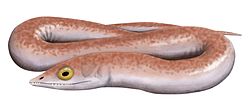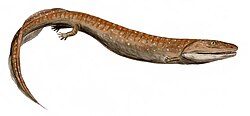| Occidens portlocki Temporal range: Early Carboniferous, Tournaisian | |
|---|---|
 | |
| Portlock's 1843 illustration of the jaw of Occidens portlocki, which he attributed to Holoptychius ; inner surface (top) and outer surface (bottom) | |
| Scientific classification | |
| Domain: | Eukaryota |
| Kingdom: | Animalia |
| Phylum: | Chordata |
| Clade: | Sarcopterygii |
| Clade: | Tetrapodomorpha |
| Clade: | Stegocephali |
| Genus: | † Occidens Clack and Ahlberg, 2004 |
| Species: | †O. portlocki |
| Binomial name | |
| †Occidens portlocki Clack and Ahlberg, 2004 | |
Occidens is an extinct genus of stem tetrapod from the Early Carboniferous (Tournaisian) Altagoan Formation of Northern Ireland. It is known from a single type species, Occidens portlocki, named in 2004 [1] on the basis of a left lower jaw described by British geologist Joseph Ellison Portlock in 1843. [2]





